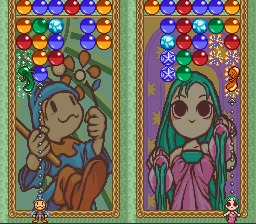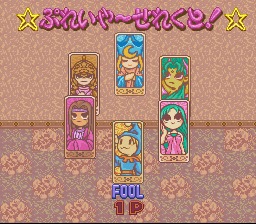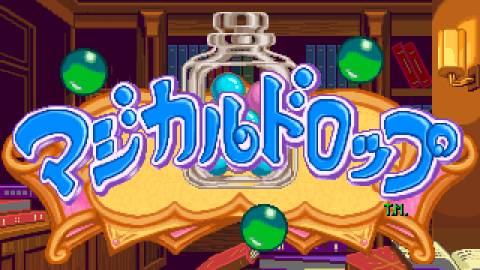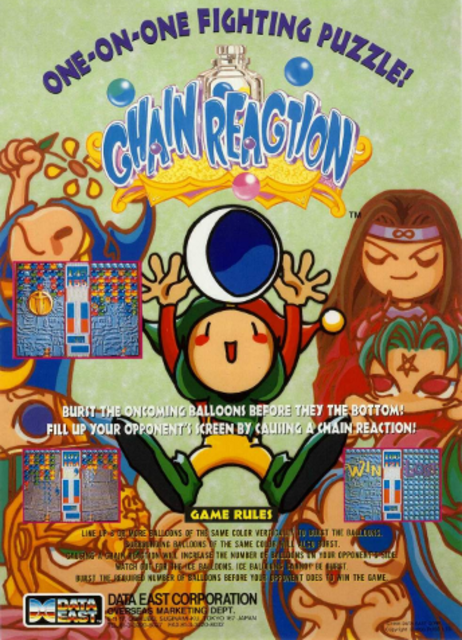Overview

Chain Reaction (known in Japan as Magical Drop) is a tile-matching puzzle game developed and released by Data East for arcades throughout 1995.
An adaptation of an obscure Russian DOS game called Drop-Drop, Chain Reaction is known for its cute art style (with characters based on tarot cards) and two-player competitive gameplay. Players control a little clown at the bottom of their playfields and try to arrange groups of tiles to make them disappear before a tile reaches past the bottom of the playfield. This is done by pulling down similar tiles (and throwing them back up) to match.
The game includes two game modes: the one-player score-based Solo Play (where additional lines of tiles regularly drop from the top of the screen) and two-player competitive Battle Mode (where the second player can be human or CPU opponents). Similar to Tetris Attack, players can make "chain reactions" by quickly creating near-simultaneous matches to either boost their score (in Solo Play) or fill up more of their opponent's playfield (in Battle Mode).
The original Japanese version of the arcade had a minor update, titled Magical Drop PLUS 1!, which fixed an issue with the timing window of chain reactions. This was used as the base for the international version, which also includes an announcer (to replace the character voices) and different sets of tiles (replacing colored bubbles with a random group of figures, including snacks, chess pieces, card suits, and slot machine symbols). The game received numerous sequels with the Magical Drop name, adding new characters while building on the game engine.
The game was ported to the Super Famicom on October 20, 1995, reducing the length of the playfield. This version was later digitally re-released for the Wii (via Virtual Console) by G-mode on May 29, 2007. It was also ported to the Sega Saturn (on December 15, 1995) and Sony PlayStation (on January 13, 1996), changing the game's art style to pre-rendered 3D characters and replacing the design of some characters. The PS1 version was re-released in November 28, 2002 by Hamster and was digitally re-released for the PlayStation Network (for the PlayStation 3 and PlayStation Portable) by Hamster on December 26, 2007. While all of the above ports and re-releases were released exclusively to Japan, the PSN version was later released internationally by MonkeyPaw in late 2011.
Gameplay
A stack of random colored bubbles descend, the player's "clown" can then attempt to arrange them in stacks of three, which will cause them to be destroyed as well as any horizontally adjacent bubbles of the same color. Chains may be formed in typical puzzle game fashion either with a single drop, or by multiple drops in quick succession.
The game is always played against either another human player, or a computer controlled player. Chain reactions cause the opponent's stack to descend at a faster rate.
Characters
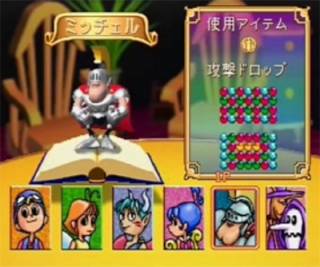
It has six playable characters named for tarot cards:
- Fool
- Magician
- High Priestess
- Star
- Devil
- Chariot
In addition, World is a non-playable boss character that would become available in future games.
Most of the characters were re-designed and re-named for the home releases; as an example, Chariot was re-named "Mitchell" and given a "butt-chin" in the PlayStation version, while Devil looks much the same, but was re-named "Warilin".

 Super Nintendo Entertainment System
Super Nintendo Entertainment System PlayStation
PlayStation Wii Shop
Wii Shop.png) PlayStation Network (PS3)
PlayStation Network (PS3).png) PlayStation Network (PSP)
PlayStation Network (PSP)



